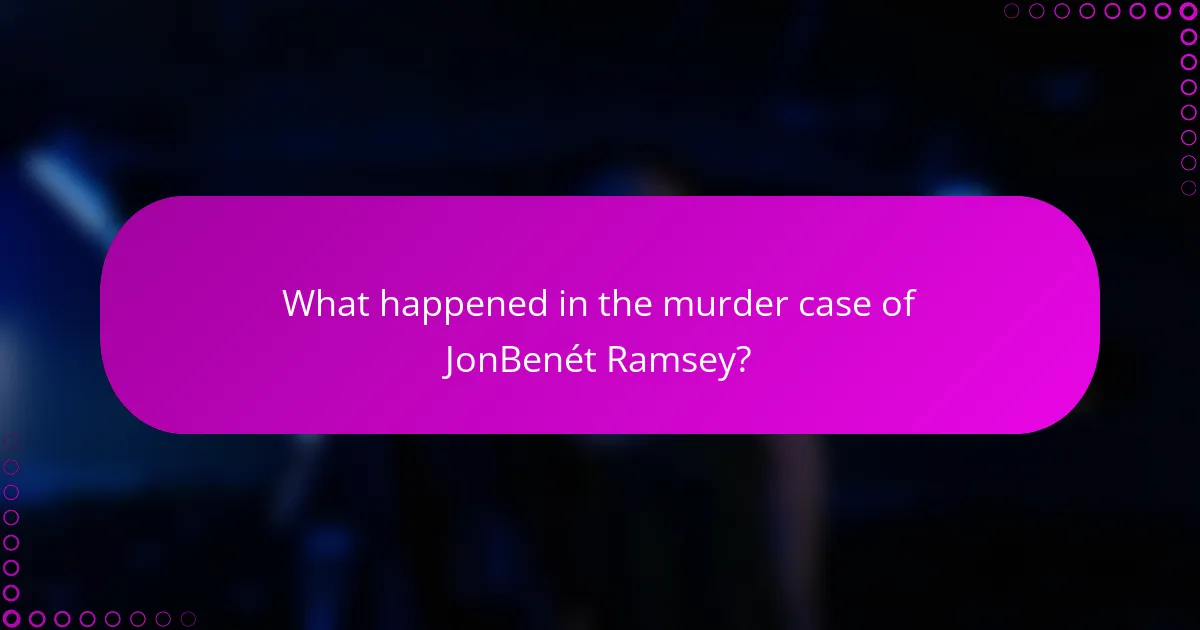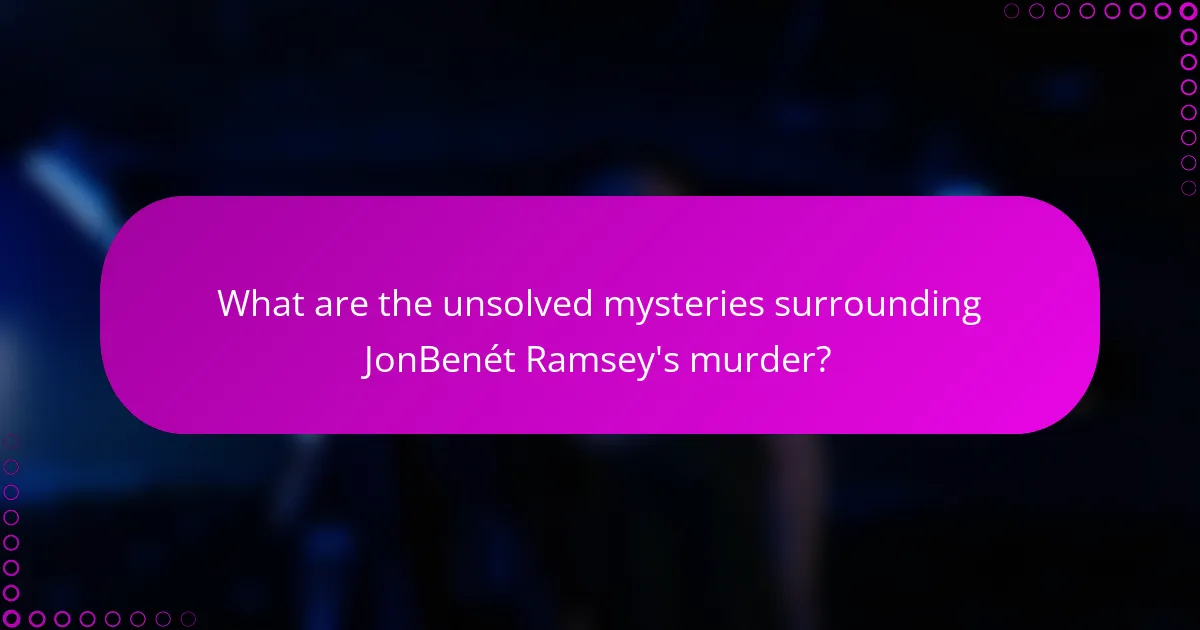JonBenét Ramsey, a six-year-old girl, was found murdered in her family’s home in Boulder, Colorado, on December 26, 1996. The case, which has remained unsolved, attracted significant media attention due to the discovery of a ransom note that suggested a planned abduction. Despite extensive investigations and the clearing of her parents through DNA evidence in 2008, no credible suspects have emerged. Key unresolved issues include the authenticity of the ransom note, the cause of death, and the unclear timeline of events on the night of the murder. The ongoing intrigue surrounding the case continues to spark public interest and speculation.

What happened in the murder case of JonBenét Ramsey?
JonBenét Ramsey was found murdered in her family’s home in Boulder, Colorado, on December 26, 1996. She was six years old at the time of her death. The case garnered immense media attention and remains unsolved. A ransom note was discovered in the home, indicating that her abduction was planned. Despite extensive investigations, no one was charged with her murder. The case has seen various theories and suspects over the years. In 2008, DNA evidence cleared her parents of suspicion. The investigation continues to be a topic of public interest and speculation.
How did the investigation begin?
The investigation into the murder of JonBenét Ramsey began shortly after her body was discovered. On December 26, 1996, police received a 911 call reporting her missing. The call was made by her mother, Patsy Ramsey, who claimed to have found a ransom note. The note demanded $118,000 for JonBenét’s safe return. When police arrived at the Ramsey home, they conducted a search. During this search, JonBenét’s body was found in the basement. The circumstances of her death led to a complex investigation. This investigation would span several years and involve numerous theories and suspects.
What were the initial findings at the crime scene?
The initial findings at the crime scene included the discovery of JonBenét Ramsey’s body in the basement of her home. The body was found on December 26, 1996, approximately eight hours after her parents reported her missing. She had been covered with a white blanket. There were signs of trauma, including a ligature around her neck. Additionally, there was evidence of a head injury. The scene also revealed a ransom note left by the perpetrator. This note was unusually lengthy and detailed, demanding a specific amount of money. The initial findings raised numerous questions about the circumstances surrounding her death.
Who were the key individuals involved in the early stages?
The key individuals involved in the early stages of the JonBenét Ramsey case include JonBenét’s parents, John and Patsy Ramsey. They discovered their daughter missing on December 26, 1996. The Ramseys reported her disappearance to the police, initiating the investigation. Detective Linda Arndt was one of the first responders at the scene. She interacted with the Ramseys and conducted initial interviews. Boulder police officers also arrived to secure the scene. These individuals played crucial roles in the early investigation efforts.
What were the major developments in the investigation timeline?
The major developments in the investigation timeline of JonBenét Ramsey’s murder include key events that shaped the case. The initial investigation began on December 26, 1996, when JonBenét’s body was discovered in her family’s basement. In the following days, the police conducted interviews and collected evidence. In 1997, the Ramsey family appeared on national television to plead for information. By 1998, the investigation faced scrutiny as various theories emerged. In 2000, a grand jury was convened but did not indict anyone. In 2006, new DNA evidence was tested, leading to renewed interest in the case. In 2016, the Boulder Police Department announced they were still actively investigating the case. Each of these developments contributed to the ongoing mystery surrounding JonBenét’s murder.
How did the police handle the case in the first few days?
The police initially handled the JonBenét Ramsey case by securing the crime scene and interviewing family members. They arrived at the Ramsey home on December 26, 1996, shortly after the 911 call. Officers quickly established a perimeter to prevent contamination of evidence. They conducted interviews with JonBenét’s parents, John and Patsy Ramsey, as well as other family members present. The police also searched the house for any signs of forced entry or additional victims. In the early days, the investigation faced challenges due to the family’s high profile and media attention. The police did not initially treat the case as a homicide, which complicated the early investigative efforts. These actions set the foundation for the ongoing investigation into the murder.
What significant evidence was collected during the investigation?
The significant evidence collected during the investigation of JonBenét Ramsey’s murder includes her body, found in the basement of her home. The autopsy revealed that she died from a blunt force trauma to the head and asphyxiation. A ransom note was discovered at the scene, demanding $118,000. The note’s handwriting was analyzed but did not yield conclusive results. The police collected various items from the crime scene, including a broken window, which suggested a potential point of entry. DNA evidence was also gathered, including a sample from her underwear. This DNA was later tested but did not match any known suspects. Additionally, several witnesses were interviewed, providing various accounts of the events surrounding her disappearance. These pieces of evidence have remained crucial in the ongoing investigation.
Why did the media become so involved in the JonBenét Ramsey case?
The media became heavily involved in the JonBenét Ramsey case due to its sensational nature and the age of the victim. JonBenét was a six-year-old beauty queen, which attracted significant public interest. The mysterious circumstances surrounding her death fueled speculation and intrigue. The case featured elements such as a ransom note, a high-profile family, and a lack of clear suspects. Media coverage heightened as the investigation unfolded, leading to widespread attention. The combination of tragedy, mystery, and the media’s role in shaping narratives made it a focal point for news outlets. This intense coverage continues to influence public perception and discussions surrounding the case today.
How did media coverage influence public perception of the case?
Media coverage significantly shaped public perception of the JonBenét Ramsey case. Extensive media reporting created a sensational narrative around the investigation. The coverage included speculation about family involvement and highlighted various theories. This constant media presence fueled public intrigue and concern. Polls indicated that many people formed opinions based on media portrayals rather than facts. The media’s framing often led to misconceptions about the case details. As a result, public trust in law enforcement’s handling of the case fluctuated. The pervasive media narrative contributed to ongoing public fascination and debate surrounding the unsolved mystery.
What role did media speculation play in the investigation?
Media speculation significantly influenced the investigation into the murder of JonBenét Ramsey. The intense coverage created a public narrative that affected how authorities approached the case. Media reports often presented unverified theories, leading to confusion and misdirection. This speculation sometimes pressured investigators to follow leads that lacked substantial evidence. The high-profile nature of the case amplified scrutiny on law enforcement actions. Consequently, investigators faced challenges in maintaining focus on factual evidence amidst the swirling rumors. The media’s role in shaping public perception complicated the investigation’s integrity and trajectory.

What are the unsolved mysteries surrounding JonBenét Ramsey’s murder?
The unsolved mysteries surrounding JonBenét Ramsey’s murder include the identity of the intruder. Despite extensive investigation, no credible suspect has been identified. The ransom note’s authenticity remains in question. Some experts believe it was written by someone within the family. The cause of death is ambiguous, with debates over whether it was accidental or intentional. The timeline of events on the night of the murder is unclear. Conflicting witness statements complicate the investigation. The role of the police and media in the case raises questions about procedural errors. These factors contribute to the ongoing intrigue and mystery surrounding the case.
What theories have emerged about the identity of the perpetrator?
Theories about the identity of the perpetrator in the JonBenét Ramsey case include several key suspects. One prominent theory implicates a family member, suggesting that an intrafamilial conflict led to the crime. Another theory points to an unidentified intruder, supported by evidence of an open basement window. Some investigators have speculated about a potential [censured] predator in the area, based on similar past incidents. Additionally, a theory emerged regarding a possible kidnapping gone wrong. Each theory has been fueled by various pieces of evidence and witness testimonies. Despite extensive investigation, no definitive conclusion has been reached. The case remains one of the most discussed unsolved mysteries in American history.
How do these theories differ from the official investigation findings?
Theories surrounding the murder of JonBenét Ramsey often differ significantly from official investigation findings. Many theories suggest intruder involvement, while official findings lean towards family involvement. Theories frequently emphasize circumstantial evidence, whereas the official investigation relies on forensic evidence. Additionally, some theories propose elaborate conspiracies, contrasting with the official investigation’s more straightforward narrative. The official investigation concluded that there was no evidence of forced entry, which contradicts theories that assume an outsider’s involvement. These differences highlight the divergence between speculation and evidence-based conclusions in the case.
What are the most compelling pieces of evidence supporting these theories?
The most compelling pieces of evidence supporting theories in the JonBenét Ramsey case include the 911 call made by Patsy Ramsey. This call was made on December 26, 1996, reporting JonBenét missing. The call was analyzed for emotional response and has been scrutinized for its authenticity. The ransom note found in the Ramsey home is another significant piece of evidence. It was unusually long, measuring 2.5 pages, and contained specific details that suggested knowledge of the family. Additionally, the forensic evidence collected from the crime scene, including DNA found on JonBenét’s body, has been analyzed extensively. However, this DNA has not conclusively linked any suspects to the crime. The presence of a broken basement window raised questions about potential intruders. Investigators considered this alongside the lack of forced entry. Each of these pieces of evidence has been pivotal in shaping various theories about the case.
Why has the case remained unsolved for so long?
The case has remained unsolved for so long due to a combination of factors. Initial investigations faced significant missteps and miscommunication. Evidence was mishandled, leading to contamination. The high-profile nature of the case complicated the investigation. Media scrutiny created pressure that may have influenced police decisions. Multiple theories emerged, causing confusion and distraction. Inconsistent witness statements hindered the search for truth. The lack of definitive physical evidence left investigators without clear leads. These elements combined have contributed to the enduring mystery surrounding JonBenét Ramsey’s murder.
What challenges have investigators faced in solving the case?
Investigators faced several challenges in solving the JonBenét Ramsey case. The case was complicated by a lack of physical evidence at the crime scene. Investigators also contended with a highly publicized media frenzy, which influenced public perception and the investigation process. Additionally, the initial handling of the crime scene was criticized, as several individuals were allowed access before it was secured. Witnesses provided conflicting statements, complicating the timeline of events. The family’s cooperation fluctuated, creating barriers to obtaining crucial information. Furthermore, the case remained cold for years, leading to a loss of potential leads and evidence over time. These factors collectively hindered the investigation’s progress and resolution.
How have advancements in forensic technology impacted the investigation?
Advancements in forensic technology have significantly improved criminal investigations. Techniques such as DNA profiling have become essential in solving cases. For instance, DNA evidence can now be extracted from smaller samples than ever before. This allows investigators to link suspects to crime scenes more effectively. Additionally, advancements in digital forensics aid in recovering deleted data from devices. High-resolution imaging and 3D scanning provide detailed crime scene reconstructions. These technologies enhance the accuracy of evidence collection and analysis. Overall, modern forensic methods increase the likelihood of solving complex cases, including high-profile ones like the JonBenét Ramsey investigation.
What lessons can be learned from the JonBenét Ramsey case?
The JonBenét Ramsey case teaches important lessons about media influence on investigations. Media coverage can lead to public speculation and pressure on law enforcement. The case highlights the need for careful handling of evidence to avoid contamination. It also underscores the importance of thorough initial investigations. Additionally, the case illustrates the challenges of solving crimes in high-profile situations. The complexities of family dynamics can impact investigative directions. Lastly, it emphasizes the need for ongoing support for affected families during investigations.
How can future investigations improve based on this case?
Future investigations can improve by implementing advanced forensic technologies. Techniques such as DNA analysis have evolved significantly since the initial investigation. Utilizing these methods can provide clearer evidence from the crime scene. Additionally, incorporating behavioral analysis can help in understanding the psychological aspects of the case. Training investigators in modern investigative techniques is crucial. Collaboration with specialized agencies can enhance resource availability. Continuous review of the case with fresh eyes can uncover overlooked details. Engaging the public through updated communication strategies may yield new leads.
What best practices should law enforcement adopt when handling high-profile cases?
Law enforcement should prioritize transparency and communication when handling high-profile cases. Clear communication helps manage public expectations and reduces misinformation. Establishing a media strategy is essential to control the narrative. Regular updates can prevent speculation and maintain public trust. Collaboration with media outlets can ensure accurate reporting.
Additionally, law enforcement should implement a case management system to track information efficiently. This helps streamline communication among various departments involved. Training personnel on high-profile case protocols is crucial for consistency.
Furthermore, maintaining the integrity of the investigation is vital. Limiting access to sensitive information protects the case from external interference. Engaging with community stakeholders can foster support and cooperation.
These practices contribute to effective management of high-profile cases, ensuring thorough investigations and public confidence.
The main entity of this article is the murder case of JonBenét Ramsey, a six-year-old girl found dead in her family’s Boulder, Colorado home on December 26, 1996. The article provides a comprehensive overview of the investigation timeline, highlighting significant findings, key individuals involved, and the challenges faced by law enforcement. It also examines the intense media coverage that surrounded the case, its impact on public perception, and the various theories regarding the identity of the perpetrator. Furthermore, it addresses the ongoing unsolved mysteries and lessons learned from the case, emphasizing the importance of forensic advancements and best practices for handling high-profile investigations.


